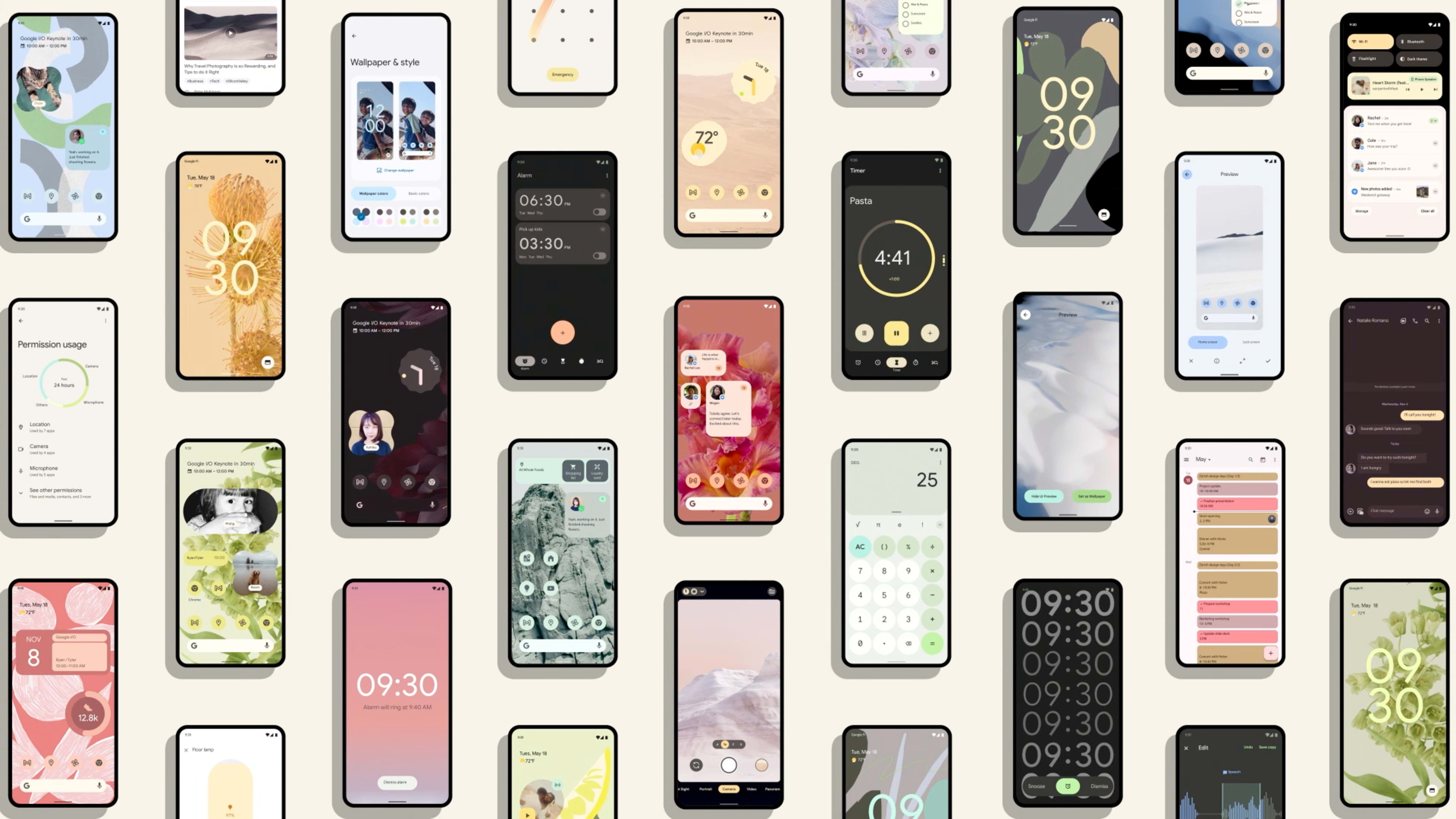With a personalized color scheme on the outside and a reinforced app-privacy structure on the inside, the next version of Android should at least avoid a common fate of some previous Android updates: being mistaken for one of its predecessors.
Android 12, previewed in detail on Tuesday at Google’s I/O developer conference, leads off with those changes to form and function. But the next edition of its mobile operating system bundles many less obvious—but still notable—changes, including some that didn’t get mentioned during the two-hour keynote that opened the online event.
Material You
While many operating systems have offered personalization features, Google’s concept aims to make customization an automatic feature, not a distraction for interface nerds. Android 12 will derive highlight and contrast colors for its interface by analyzing your screen wallpaper.
If your own screen decor already matches the current Android palette, you should still notice how many onscreen elements will be less rectilinear. For example, Google has already advised developers of onscreen widgets to get ready for rounded corners.

Quick Settings
The set of toggles for such functions as airplane mode (remember that?) that you can invoke by swiping deeply down from the top of the screen should look a lot different in Android 12. The tiles you see today will be replaced by larger panes that show more detail about the state of each function.
Android 12’s Quick Settings will also fold in new features. For instance, it will add the shortcuts to change Google Pay payment methods and control smart-home gadgets that Android 11 hides behind a long press of the power button.
Privacy Dashboard
The last few versions of Android have offered more visible and detailed controls about which apps can read what sorts of data. Android 12’s Privacy Dashboard should advance that work by revealing how often any apps—including Google ones—have tapped into your phone’s location, camera, or microphone in the last 24 hours.
As in Android 11, apps that go unused for long enough will get all their permissions reset to zero by the operating system. But Android 12 will also put these neglected apps into a “hibernation” state, zeroing out their temporary files to recover storage space.
Other privacy controls
Android 12 will follow some privacy templates in Apple’s iOS closely enough to invite the nickname “aOS.” Like iOS 14, Android 12 will flash a notification at the top right of the screen when an app uses the camera or microphone—although these alerts will include distinct icons for each. The Quick Settings menu will let users kill that access for the app in question—or deactivate the camera and mic for every app.
Android 12 will further echo iOS in letting users grant an app access to only your approximate location. This may crimp the location-snooping habits of in-app ads—and the data-broker business generated from that information.
And finally, just as iOS 14 flashes a notification whenever any app reads from the clipboard, Android 12 will surface a similar tip.
Private Compute Core
Google spent much of day one of I/O pledging its commitment to “federated learning,” in which sensitive data stays on a device for analysis instead of introducing the privacy concerns that come when such data gets uploaded for processing in a distant data center. (Apple’s term for that concept: “on-device intelligence.”)
[Animation: courtesy of Google]Android 12 will add something called “Private Compute Core.” It consists of open-source software isolated from the network—a bit like the locked-down Android code that handles biometric authentication—that secures such on-device work as the “Now Playing” feature that identifies music playing in the background. At I/O, Google executives suggested that more such functions would take up residence in this protective enclave.
Guest mode, but not quite for you
Android users in the developing world will get a bonus feature that distracted parents in the U.S. might appreciate: a guest mode easily accessible from the lock screen in Android Go, the OS edition that Google provides for cheaper, relatively underpowered phones.
This feature already exists in Android, but it’s deeply buried in the Settings app—and will remain so for mainstream users in the U.S. and other mainstream markets.
What about updates?
One long-standing problem with new Android system releases is the failure of phone manufacturers and wireless carriers to issue them for older devices. This issue went unmentioned at this year’s I/O—unlike in previous years—but one industry analyst suggests that Google and its partners had made real progress.
“Things are improving somewhat,” emailed Avi Greengart, president and lead analyst at Techsponential. His causes for optimism: “efforts by Google and Qualcomm to make it easier for Android licensees to keep their phones up to date, but also by key Android vendors responding to lengthening replacement cycles and competition from Apple.”
For example, Qualcomm—the company behind U.S.-market Android chipsets—committed in December to ship three years of software updates for the foundational code that lets its processors talk to Android. And last August, Samsung pledged to keep many of its phones current through the next three major Android updates.
But Samsung is also still working to deliver Android 11 to some of its older phones. So if you’re reading this story on a Samsung Galaxy phone, there’s no guarantee that you’ll see Android 12 land on that device before early 2022–maybe.
Recognize your brand’s excellence by applying to this year’s Brands That Matter Awards before the final deadline, June 7.
Sign up for Brands That Matter notifications here.
